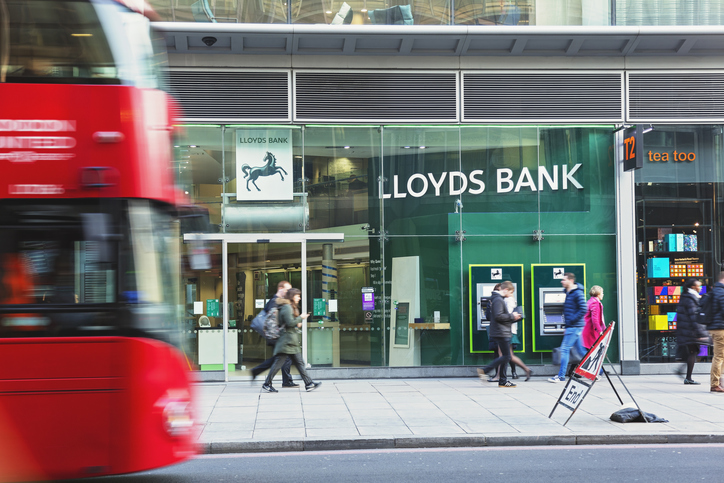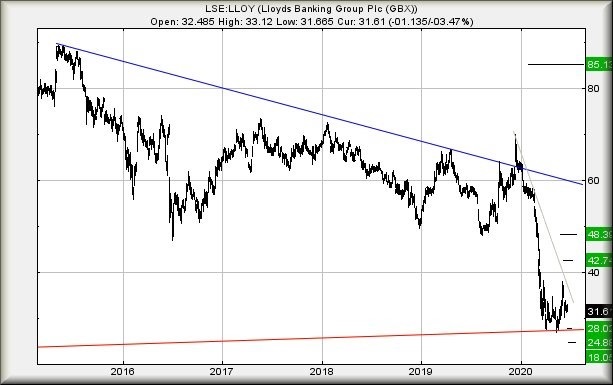Lloyds Bank shares must do this before any rise can be taken seriously
After once again failing to make a recovery stick, this chartist examines what might trigger a move.
25th June 2020 08:26
by Alistair Strang from Trends and Targets
Share on
After once again failing to make a recovery stick, this chartist examines what might trigger a move.

Lloyds Banking Group (LSE:LLOY)
On the subject of Lloyds Banking Group (LSE:LLOY), we're feeling like one of these annoying cat gifs, the sort of thing you watch until the penny drops that the video has been repeating.
Since the start of June, Lloyds has made us regret our plan to monitor the share every few weeks.
With all that's been going on recently, it was to take a special level of skill for Lloyds to move by just 4p since we last reviewed the price and, unfortunately, the majority of perceived movement occurred due to the price being manipulated (gapped) at the start of trading.
Despite a couple of indications the price should be heading upward, we fear this is going to be one of these things where recovery will probably not prove possible until some volatility occurs.
In the case of Lloyds, we suspect this shall require reversal down to 28p before a bounce happens.
Thankfully, there's an uptrend (red on the chart below) dating back to 2011 which certainly gives sufficient hope a bunch of traders, armed with crayons, will see the share reverse and decide a bounce must take place.
Of course, it all becomes a little problematical should 28p break as our secondary target works out at 24.8p.
In today's marketplace, we'd not be surprised to see Lloyds find an excuse to panic the market by being gapped down toward the 25p level at the open one day, if sufficient excuse is found.
But, critically, if such nonsense takes place, we'd also expect the share to close the session at around the 28p level, thus making any break below red a momentary thing.
It would certainly "stiff" any folk who place a buy order for the 28p level, along with a stop position 10% away.
This sort of nuisance event actually does happen, a drop triggers a buy and a few seconds later triggers the stop.
This can cost traders dearly by creating a situation where a trade didn't actually happen and, usually, to rub salt in the wound, the share price will ideally close the session above the 28p level anyway.
The moral is fairly straightforward. If going after something volatile, get out of bed and trade rather than rely on an automated series of orders.
We're not inclined to take any rise seriously on Lloyds until the share price exceeds 38p. This is liable to prove significant, allowing movement to 42.7p initially with secondary, if bettered, at 48p.

Source: Trends and Targets Past performance is not a guide to future performance
Alistair Strang has led high-profile and "top secret" software projects since the late 1970s and won the original John Logie Baird Award for inventors and innovators. After the financial crash, he wanted to know "how it worked" with a view to mimicking existing trading formulas and predicting what was coming next. His results speak for themselves as he continually refines the methodology.
Alistair Strang is a freelance contributor and not a direct employee of Interactive Investor. All correspondence is with Alistair Strang, who for these purposes is deemed a third-party supplier. Buying, selling and investing in shares is not without risk. Market and company movement will affect your performance and you may get back less than you invest. Neither Alistair Strang, or interactive investor will be responsible for any losses that may be incurred as a result of following a trading idea.
Alistair Strang has led high-profile and "top secret" software projects since the late 1970s and won the original John Logie Baird Award for inventors and innovators. After the financial crash, he wanted to know "how it worked" with a view to mimicking existing trading formulas and predicting what was coming next. His results speak for themselves as he continually refines the methodology.
Alistair Strang is a freelance contributor and not a direct employee of Interactive Investor. All correspondence is with Alistair Strang, who for these purposes is deemed a third-party supplier. Buying, selling and investing in shares is not without risk. Market and company movement will affect your performance and you may get back less than you invest. Neither Alistair Strang or Interactive Investor will be responsible for any losses that may be incurred as a result of following a trading idea.
These articles are provided for information purposes only. Occasionally, an opinion about whether to buy or sell a specific investment may be provided by third parties. The content is not intended to be a personal recommendation to buy or sell any financial instrument or product, or to adopt any investment strategy as it is not provided based on an assessment of your investing knowledge and experience, your financial situation or your investment objectives. The value of your investments, and the income derived from them, may go down as well as up. You may not get back all the money that you invest. The investments referred to in this article may not be suitable for all investors, and if in doubt, an investor should seek advice from a qualified investment adviser.
Full performance can be found on the company or index summary page on the interactive investor website. Simply click on the company's or index name highlighted in the article.